Advertisements
Online Mock Tests
Chapters
2: Electrostatic Potential And Capacitance
3: Current Electricity
▶ 4: Moving Charges And Magnetism
5: Magnetism And Matter
6: Electromagnetic Induction
7: Alternating Current
8: Electromagnetic Waves
9: Ray Optics And Optical Instruments
10: Wave Optics
11: Dual Nature Of Radiation And Matter
12: Atoms
13: Nuclei
14: Semiconductor Electronics
15: Communication Systems
![NCERT Exemplar solutions for Physics [English] Class 12 chapter 4 - Moving Charges And Magnetism NCERT Exemplar solutions for Physics [English] Class 12 chapter 4 - Moving Charges And Magnetism - Shaalaa.com](/images/physics-english-class-12_6:5f2b1b2038084cf381bfa42c826a928c.jpg)
Advertisements
Solutions for Chapter 4: Moving Charges And Magnetism
Below listed, you can find solutions for Chapter 4 of CBSE NCERT Exemplar for Physics [English] Class 12.
NCERT Exemplar solutions for Physics [English] Class 12 4 Moving Charges And Magnetism MCQ I [Pages 22 - 27]
Two charged particles traverse identical helical paths in a completely opposite sense in a uniform magnetic field B = B0k̂.
They have equal z-components of momenta.
They must have equal charges.
They necessarily represent a particle-antiparticle pair.
The charge to mass ratio satisfy : `(e/m)_1 + (e/m)_2 = 0`.
Biot-Savart law indicates that the moving electrons velocity (V) produce a magnetic field B such that ______.
- B ∥ v.
- B ⊥ v.
- it obeys inverse cube law.
- it is along the line joining electron and point of observation.
A current carrying circular loop of radius R is placed in the x-y plane with centre at the origin. Half of the loop with x > 0 is now bent so that it now lies in the y-z plane.
The magnitude of magnetic moment now diminishes.
The magnetic moment does not change.
The magnitude of B at (0, 0, z), z > R increases.
The magnitude of B at (0, 0, z), z >> R is unchanged.
An electron is projected with uniform velocity along the axis of a current carrying long solenoid. Which of the following is true?
The electron will be accelerated along the axis.
The electron path will be circular about the axis.
The electron will experience a force at 45° to the axis and hence execute a helical path.
The electron will continue to move with uniform velocity along the axis of the solenoid.
In a cyclotron, a charged particle ______.
undergoes acceleration all the time.
speeds up between the dees because of the magnetic field.
speeds up in a dee.
slows down within a dee and speeds up between dees.
A circular current loop of magnetic moment M is in an arbitrary orientation in an external magnetic field B. The work done to rotate the loop by 30° about an axis perpendicular to its plane is ______.
`MB`.
`sqrt(3) (MB)/2`.
`(MB)/2`.
zero.
The gyro-magnetic ratio of an electron in an H-atom, according to Bohr model, is ______.
- independent of which orbit it is in.
- negative.
- positive.
- increases with the quantum number n.
a and b
a and c
b and c
c and d
Consider a wire carrying a steady current, I placed in a uniform magnetic field B perpendicular to its length. Consider the charges inside the wire. It is known that magnetic forces do no work. This implies that ______.
- motion of charges inside the conductor is unaffected by B since they do not absorb energy.
- some charges inside the wire move to the surface as a result of B.
- if the wire moves under the influence of B, no work is done by the force.
- if the wire moves under the influence of B, no work is done by the magnetic force on the ions, assumed fixed within the wire.
b and c
a and d
b and d
c and d
Two identical current carrying coaxial loops, carry current I in an opposite sense. A simple amperian loop passes through both of them once. Calling the loop as C ______.
- `oint B.dl = +- 2μ_0I`
- the value of `oint B.dl` is independent of sense of C.
- there may be a point on C where B and dl are perpendicular.
- B vanishes everywhere on C.
a and b
a and c
b and c
c and d
A cubical region of space is filled with some uniform electric and magnetic fields. An electron enters the cube across one of its faces with velocity v and a positron enters via opposite face with velocity – v. At this instant ______.
- the electric forces on both the particles cause identical accelerations.
- the magnetic forces on both the particles cause equal accelerations.
- both particles gain or loose energy at the same rate.
- the motion of the centre of mass (CM) is determined by B alone.
a, b and c
a, c and d
b, c and d
c and d
A charged particle would continue to move with a constant velocity in a region wherein ______.
- E = 0, B ≠ 0.
- E ≠ 0, B ≠ 0.
- E ≠ 0, B = 0.
- E = 0, B = 0.
a and c
b and d
a, b and d
c and d
Verify that the cyclotron frequency ω = eB/m has the correct dimensions of [T]–1.
Show that a force that does no work must be a velocity dependent force.
The magnetic force depends on v which depends on the inertial frame of reference. Does then the magnetic force differ from inertial frame to frame? Is it reasonable that the net acceleration has a different value in different frames of reference?
Describe the motion of a charged particle in a cyclotron if the frequency of the radio frequency (rf) field were doubled.
Two long wires carrying current I1 and I2 are arranged as shown in figure. The one carrying current I1 is along is the x-axis. The other carrying current I2 is along a line parallel to the y-axis given by x = 0 and z = d. Find the force exerted at O2 because of the wire along the x-axis.
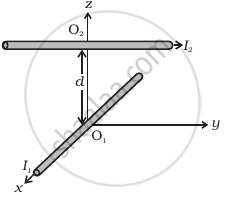
A current carrying loop consists of 3 identical quarter circles of radius R, lying in the positive quadrants of the x-y, y-z and z-x planes with their centres at the origin, joined together. Find the direction and magnitude of B at the origin.
A charged particle of charge e and mass m is moving in an electric field E and magnetic field B. Construct dimensionless quantities and quantities of dimension [T]–1.
An electron enters with a velocity v = v0i into a cubical region (faces parallel to coordinate planes) in which there are uniform electric and magnetic fields. The orbit of the electron is found to spiral down inside the cube in plane parallel to the x-y plane. Suggest a configuration of fields E and B that can lead to it.
Do magnetic forces obey Newton’s third law. Verify for two current elements dl1 = dlî located at the origin and dl2 = dlĵ located at (0, R, 0). Both carry current I.
A multirange voltmeter can be constructed by using a galvanometer circuit as shown in figure. We want to construct a voltmeter that can measure 2V, 20V and 200V using a galvanometer of resistance 10Ω and that produces maximum deflection for current of 1 mA. Find R1, R2 and R3 that have to be used.
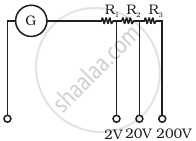
A long straight wire carrying current of 25 A rests on a table as shown in figure. Another wire PQ of length 1 m, mass 2.5 g carries the same current but in the opposite direction. The wire PQ is free to slide up and down. To what height will PQ rise?
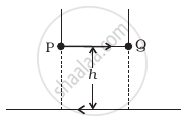
A 100 turn rectangular coil ABCD (in XY plane) is hung from one arm of a balance (Figure). A mass 500 g is added to the other arm to balance the weight of the coil. A current 4.9 A passes through the coil and a constant magnetic field of 0.2 T acting inward (in xz plane) is switched on such that only arm CD of length 1 cm lies in the field. How much additional mass ‘m’ must be added to regain the balance?
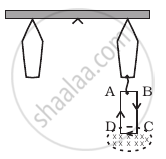
A rectangular conducting loop consists of two wires on two opposite sides of length l joined together by rods of length d. The wires are each of the same material but with cross-sections differing by a factor of 2. The thicker wire has a resistance R and the rods are of low resistance, which in turn are connected to a constant voltage source V0. The loop is placed in uniform a magnetic field B at 45° to its plane. Find τ, the torque exerted by the magnetic field on the loop about an axis through the centres of rods.
An electron and a positron are released from (0, 0, 0) and (0, 0, 1.5R ) respectively, in a uniform magnetic field B = B0î, each with an equal momentum of magnitude p = e BR. Under what conditions on the direction of momentum will the orbits be non-intersecting circles?
A uniform conducting wire of length 12a and resistance R is wound up as a current-carrying coil in the shape of (i) an equilateral triangle of side a; (ii) a square of sides a and, (iii) a regular hexagon of sides a. The coil is connected to a voltage source V0. Find the magnetic moment of the coils in each case.
Consider a circular current-carrying loop of radius R in the x-y plane with centre at origin. Consider the line intergral
`ℑ(L ) = |int_(-L)^L B.dl|` taken along z-axis.
- Show that ℑ(L) monotonically increases with L.
- Use an appropriate Amperian loop to show that ℑ(∞) = µ0I, where I is the current in the wire.
- Verify directly the above result.
- Suppose we replace the circular coil by a square coil of sides R carrying the same current I. What can you say about ℑ(L) and ℑ(∞)?
A multirange current meter can be constructed by using a galvanometer circuit as shown in figure. We want a current meter that can measure 10 mA, 100 mA and 1A using a galvanometer of resistance 10 Ω and that prduces maximum deflection for current of 1mA. Find S1, S2 and S3 that have to be used
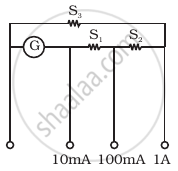
Five long wires A, B, C, D and E, each carrying current I are arranged to form edges of a pentagonal prism as shown in figure. Each carries current out of the plane of paper.
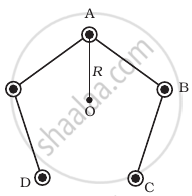
- What will be magnetic induction at a point on the axis O? AxisE is at a distance R from each wire.
- What will be the field if current in one of the wires (say A) is switched off?
- What if current in one of the wire (say) A is reversed?
Solutions for 4: Moving Charges And Magnetism
![NCERT Exemplar solutions for Physics [English] Class 12 chapter 4 - Moving Charges And Magnetism NCERT Exemplar solutions for Physics [English] Class 12 chapter 4 - Moving Charges And Magnetism - Shaalaa.com](/images/physics-english-class-12_6:5f2b1b2038084cf381bfa42c826a928c.jpg)
NCERT Exemplar solutions for Physics [English] Class 12 chapter 4 - Moving Charges And Magnetism
Shaalaa.com has the CBSE Mathematics Physics [English] Class 12 CBSE solutions in a manner that help students grasp basic concepts better and faster. The detailed, step-by-step solutions will help you understand the concepts better and clarify any confusion. NCERT Exemplar solutions for Mathematics Physics [English] Class 12 CBSE 4 (Moving Charges And Magnetism) include all questions with answers and detailed explanations. This will clear students' doubts about questions and improve their application skills while preparing for board exams.
Further, we at Shaalaa.com provide such solutions so students can prepare for written exams. NCERT Exemplar textbook solutions can be a core help for self-study and provide excellent self-help guidance for students.
Concepts covered in Physics [English] Class 12 chapter 4 Moving Charges And Magnetism are The Magnetic Dipole Moment of a Revolving Electron, Circular Current Loop as a Magnetic Dipole, Torque on a Rectangular Current Loop in a Uniform Magnetic Field, Magnetic Field on the Axis of a Circular Current Loop, Motion in a Magnetic Field, Moving Coil Galvanometer, Magnetic Force, Magnetic Field Due to a Current Element, Biot-Savart Law, Ampere’s Circuital Law, Force Between Two Parallel Currents, the Ampere, Solenoid and the Toroid - the Solenoid, Oersted’s Experiment, Solenoid and the Toroid - the Toroid, Magnetic Diapole, Sources and Fields of Magnetic Force, Magnetic Field, Lorentz Force, Magnetic Force on a Current-carrying Conductor, Torque on a Current Loop in Magnetic Field, Force on a Current - Carrying Conductor in a Uniform Magnetic Field, Force on a Moving Charge in Uniform Magnetic and Electric Fields, Straight and Toroidal Solenoids (Only Qualitative Treatment), Velocity Selector, Cyclotron.
Using NCERT Exemplar Physics [English] Class 12 solutions Moving Charges And Magnetism exercise by students is an easy way to prepare for the exams, as they involve solutions arranged chapter-wise and also page-wise. The questions involved in NCERT Exemplar Solutions are essential questions that can be asked in the final exam. Maximum CBSE Physics [English] Class 12 students prefer NCERT Exemplar Textbook Solutions to score more in exams.
Get the free view of Chapter 4, Moving Charges And Magnetism Physics [English] Class 12 additional questions for Mathematics Physics [English] Class 12 CBSE, and you can use Shaalaa.com to keep it handy for your exam preparation.
